Home waters.
For Colorado rancher Paul Bruchez, the phrase means more than a favorite local fishing stretch, although that’s part of it.
His home waters encompass a larger vision of waters that bind a community, and a way of life.
He’s spent much of his life along the Upper Colorado River, which winds through his family’s ranch near Kremmling and waters the pasture that supports the family’s cattle operation.
Paul also is a part-time fishing guide in the valley. “Only a rancher would be smart enough to supplement their income by being a fly-fishing guide,” he deadpans.
He loves ranching and fishing, and grew up immersed in both, but he knows this way of life depends on the river—and for decades, the Colorado River here has been in decline. Because of transmountain diversions to Front Range cities, drought, and other factors, he watched as the river dropped, leaving local ranchers’ irrigation pumps high and dry.
To his credit, Bruchez quickly realized that this was more than an irrigation problem. He found a study by a Colorado parks biologist that described seriously degraded river habitat in this stretch, including the loss of key health indicators such as riffle structures and stoneflies. In recent decades, the riffles and bugs had disappeared and been replaced with silt, steep eroded banks and what Bruchez calls “frog water”—slow, murky and mossy.
Looking at the degraded stretch left Bruchez wondering, “What happened to our river?”
So, a few years ago, he decided to do something about it. He talked with his neighbors about not just fixing their irrigation systems but actually fixing the river. Instead of replumbing the irrigation down to reach the river, he had the audacious idea of bringing the river levels back up. He wanted to restore flows and habitat for miles in the valley. He wanted a healthy river.
He began talking with Trout Unlimited and American Rivers. They put their heads together and came up with some innovative ideas. They launched a pilot project: on a neighbor’s ranch just outside of Kremmling, the partners brought in gravel and rocks to rebuild a point bar and reconstruct a riffle: the idea was to boost the oxygen in the water and provide cooler refuge for trout in the pool. Upstream of the riffle V, the narrower channel would back up the water, raising levels and making it more available for irrigation intakes.
At least that was the idea. Then they built it, and surprise—it worked.
The new riffle.
Bruchez likes to look at the riffle, which froths and rattles over gravel and then slides into a deep long run and is a thing of beauty. “It looks fishy now,” he says.
Almost immediately, the bugs came back. In fact, he recently scooped up a Mason jar of the big stoneflies and other bugs—like some homegrown canned goods—and took them to a meeting of the Colorado Basin Roundtable, a local water planning group for the state. Paul held up the jar and said: This is what river conservation success looks like. With a little help, he told them, the bugs will return, and with them, the foundation of the entire food chain in the river.
He and his neighbors now have funding to improve 10 miles of the river with riffle-pool structures and other habitat projects.
“These bugs will replenish themselves fairly quickly once the river is restored,” he says. And the trout will follow.
It’s working—in fact, it’s astonished him how quickly nature has responded to their efforts. A few weeks back, he took a Colorado senator to the original riffle project. As they looked at the rippling water and tailout, trout began popping everywhere on the surface, rising to a prolific bug hatch.
It was incredible timing. The senator was impressed.
Those rising trout were a vision of the future.
He holds on to those moments, because restoring home waters isn’t always glamorous work. He’s put in countless hours in recent years attending godawfully long planning meetings and crunching the mind-numbing details of construction budgets. He credits his family for covering for him on some of the ranching duties, allowing him to pursue his river work. His wife has been patient.
They understand it’s about keeping their family in this valley. Home waters.
Paul knows that their life here always comes back to the river. He wants to keep it flowing. He wants to keep it fishing. He wants to turn over rocks at the riffle’s edge and find crawling signs of life. That’s what victory looks like.
For more pictures and story on the Bruchez ranch project, read the upcoming issue of This is Fly Magazine.
The author of this piece, Randy Scholfield, is TU's director of communications for the Southwest.





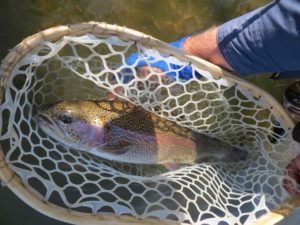
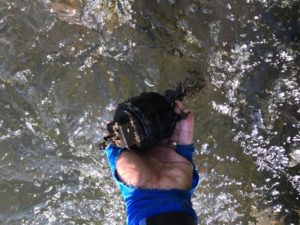
 What made you want to become involved with TU?
I grew up loving to volunteer and help others; during my involvement with the Boy Scouts of America from Cub Scout to Eagle Scout and beyond, I get a great sense of satisfaction from philanthropic endeavors. Oh- and I love to fish, so I should do my part to keep our waters clean, cold and fishable for generations to come. There is nothing better than a day on the river, (besides a day on the river catching fish) so I love being part of an organization where our work benefits my favorite pastime!.
What made you want to become involved with TU?
I grew up loving to volunteer and help others; during my involvement with the Boy Scouts of America from Cub Scout to Eagle Scout and beyond, I get a great sense of satisfaction from philanthropic endeavors. Oh- and I love to fish, so I should do my part to keep our waters clean, cold and fishable for generations to come. There is nothing better than a day on the river, (besides a day on the river catching fish) so I love being part of an organization where our work benefits my favorite pastime!. What else do you do in your spare time or for work?
I am a water resource engineer and I specialize in stream restoration and watershed management. If I am not fishing I am skiing. My entire life from professionally to personally revolves around water. My wife and I love backpacking, hiking to cool spots and exploring our amazing state with our dogs.
What else do you do in your spare time or for work?
I am a water resource engineer and I specialize in stream restoration and watershed management. If I am not fishing I am skiing. My entire life from professionally to personally revolves around water. My wife and I love backpacking, hiking to cool spots and exploring our amazing state with our dogs.
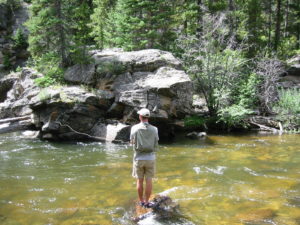 I’ve really started to love high alpine lakes, particularly backpacking into them. The solitude and natural beauty always recharges my batteries. Plus I have learned enough to usually catch some wild trout for supper. My favorite river fishing is on a stretch of the Colorado River, where my brother and I catch 18-20+ inch rainbow and brown trout. I will leave that stretch unidentified per my brother’s request.
I’ve really started to love high alpine lakes, particularly backpacking into them. The solitude and natural beauty always recharges my batteries. Plus I have learned enough to usually catch some wild trout for supper. My favorite river fishing is on a stretch of the Colorado River, where my brother and I catch 18-20+ inch rainbow and brown trout. I will leave that stretch unidentified per my brother’s request.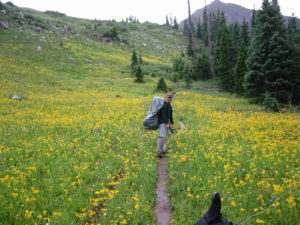 Since moving into the mountains, I have started a new career in elder care, trying to keep folks in their homes. A new focus of my fishing is the 9 wt rod I recently purchased. I’m getting into kayak fly fishing for larger fish in the Florida flats and will be fishing for some pike this summer on the Rio Grande. Love new adventures.
Since moving into the mountains, I have started a new career in elder care, trying to keep folks in their homes. A new focus of my fishing is the 9 wt rod I recently purchased. I’m getting into kayak fly fishing for larger fish in the Florida flats and will be fishing for some pike this summer on the Rio Grande. Love new adventures.
 Monday was the first full day of camp and after waking up, the kids went to the stream and pond at the ranch to learn about the entomology of the watershed. The kids took bug samples to learn about what the fish would be eating in the area and took water samples to determine the health of the stream and pond. After the sampling, students ate lunch and headed to nearby North Lake to fish for the afternoon. It wasn't long before kids started hooking into fish and in the first day over half of the kids had landed their first fish of the camp and for some, their first fish ever.
Monday was the first full day of camp and after waking up, the kids went to the stream and pond at the ranch to learn about the entomology of the watershed. The kids took bug samples to learn about what the fish would be eating in the area and took water samples to determine the health of the stream and pond. After the sampling, students ate lunch and headed to nearby North Lake to fish for the afternoon. It wasn't long before kids started hooking into fish and in the first day over half of the kids had landed their first fish of the camp and for some, their first fish ever. Over the first few days the kids had free time to tie flies and practice their fly fishing skills and on Wednesday they had a chance to hone in those skills and use the flies they have tied. The day started off by traveling to North Lake for the morning. While at North Lake kids were catching fish left and right and by halfway through the morning, everyone had caught a fish. After returning to the camp, the kids ate lunch and broke up into teams of three for some additional fishing. One group headed to some beaver ponds, another group fished the stream, and the third group fished a lake on the ranch property.
Over the first few days the kids had free time to tie flies and practice their fly fishing skills and on Wednesday they had a chance to hone in those skills and use the flies they have tied. The day started off by traveling to North Lake for the morning. While at North Lake kids were catching fish left and right and by halfway through the morning, everyone had caught a fish. After returning to the camp, the kids ate lunch and broke up into teams of three for some additional fishing. One group headed to some beaver ponds, another group fished the stream, and the third group fished a lake on the ranch property.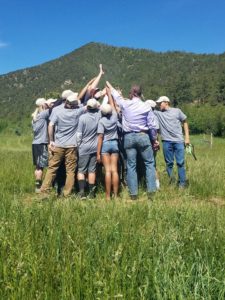 When the 15 campers arrived on June 11, there were nervous faces and uneasy feelings about what to expect for the upcoming week. But just a few days later on June 16 the campers had a hard time leaving one another. The friendships formed, the lessons learned, and the memories made will carry on forever and many students mentioned coming back in 2018.
When the 15 campers arrived on June 11, there were nervous faces and uneasy feelings about what to expect for the upcoming week. But just a few days later on June 16 the campers had a hard time leaving one another. The friendships formed, the lessons learned, and the memories made will carry on forever and many students mentioned coming back in 2018.
